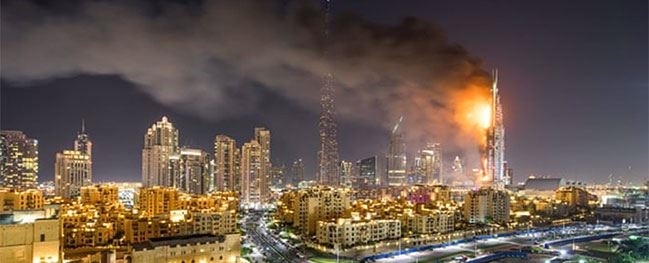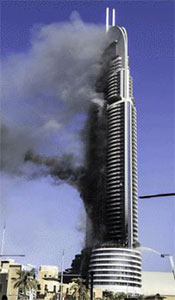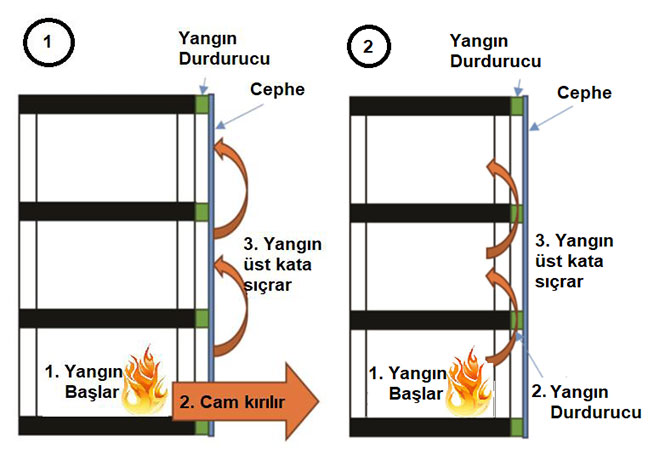
While waiting for the fireworks displays that would take place in the iconic Burj Khalifa on the night of December 31, 2015 to celebrate the New Year, a massive fire broke out at the five-star The Address Downtown Hotel.
The fire caused major turmoil in the area. An old man who had a heart attack at the hotel due to the crowd and smoke died at the scene, and at least 14 people were treated for minor injuries.
The assembled crowd saw the pieces of debris flying from the tower due to the strong winds and helplessly watched as the disaster unfolded. Then, the Dubai Police repulsed the crowd and evacuated the Dubai Mall by midnight. The roads leading to the area were cordoned off.
Major General Rashid Thani Al Matroushi, Director General of Civil Defense, said that the fire broke out at 9:30 pm and four firefighting crews from the nearby stations evacuated the hotel and the adjacent Souq Al Bahar soon after. He also added that helicopters and unmanned aerial vehicles were used in this rescue operation.
On Friday, the first morning of the year, the firefighters seemed to have almost extinguished the fire. However, after the sun rose, the clouds of white smoke could still be seen from the 63-floor burned hotel. The Civil Defense remarked on Friday that "cooling down procedures" are continuing and an investigation has been initiated.
Dubai Civil Defense said that the fire broke out on the 20th floor terrace according to a statement released by the government press office. The witnesses who saw the incident said that they believed the fire broke out on the ground floor of the building. The witnesses also reported hearing explosions. The Architect Michael Gracilla, who was present at the scene, commented on the fire as "Even though the entire building is on fire, the structure itself will not collapse. It is only the facade of the hotel that has been damaged due to the fire."
The authorities have said that they are still working to identify the cause of the fire that broke out at The Address Downtown Hotel, one of Dubai's most luxurious buildings, which includes 600 residences and a 200-room luxury hotel. They have also stated that this fire raises new questions about "building safety" in the minds of residents of the United Arab Emirates. The final report is still unclear and undisclosed.
This fire, which has engulfed one of Dubai's most important hotel skyscrapers, was caused by an electrical short circuit, probably due to the wiring connected to the spotlights outside the building.
The photos also indicate that the fire initially broke out as a result of an electrical short circuit.

 Combustible materials may significantly increase the risk of fire, as in many recent building fires. Research facilities are required to be developed to better understand the behavior of real fires involving facade systems.
Combustible materials may significantly increase the risk of fire, as in many recent building fires. Research facilities are required to be developed to better understand the behavior of real fires involving facade systems.
A good facility will facilitate scientific studies regarding facade fires and will help to prevent fires.
Facade systems in such installations are often certified in terms of their fire performance by using specific test standards.
By taking the scale and intensity of recent facade fires involving fire resistant materials into consideration, it is clear that current test standards and fire ratings are not fully valid in real fire scenarios encountered in buildings.
This disconnection between the actual performance of facade systems and test methods during a fire is due to a lack of understanding of the basic fire spread behaviors and the materials used in the building envelope.
A report by the Fire Protection Research Foundation in the USA has been also adopted recently, which aims to review all existing facade testing standards.
A realistic characterization of the fire behavior of the facade will enable it to be assessed in terms of fire. It is not expected to fill the gap between the current test standards and the real life fire performance of facade systems.
The right tests to be conducted will play an important role, particularly in the development of comprehensive fire safety guidelines that are not currently available. Considering the significant increase in the number of buildings that use facade systems, fire spread and firefighting operations in buildings will play a key role in minimizing loss of life and property in the future.
It was designed to simulate two types of typical fire spread behaviors observed in buildings that use a facade system: external spread and internal spread (Fig. 1, 2). The first mechanism is usually the leapfrog effect. The second form of the test structure was designed to simulate the external spread mechanism.
The figures have indicated the typical details of the facade installation.
